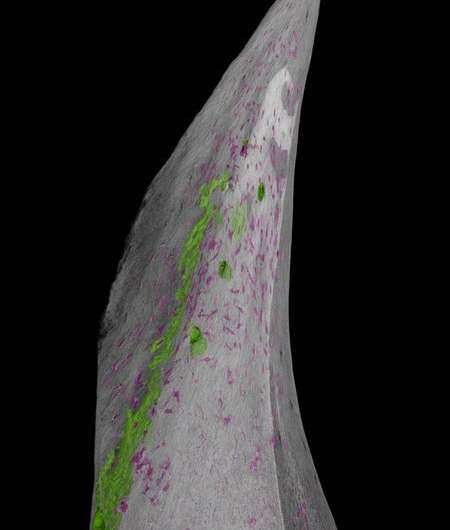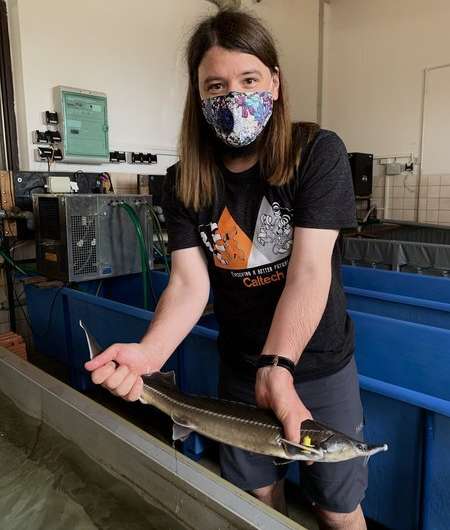This article has been reviewed according to Science X's editorial process and policies. Editors have highlighted the following attributes while ensuring the content's credibility:
fact-checked
peer-reviewed publication
trusted source
proofread
How fish evolved their bony, scaly armor

About 350 million years ago, your evolutionary ancestors—and the ancestors of all modern vertebrates—were merely soft-bodied animals living in the oceans. In order to survive and evolve to become what we are today, these animals needed to gain some protection and advantage over the ocean's predators, which were then dominated by crustaceans.
The evolution of dermal armor, like the sharp spines found on an armored catfish or the bony diamond-shaped scales, called scutes, covering a sturgeon, was a successful strategy. Thousands of species of fish utilized varying patterns of dermal armor, composed of bone and/or a substance called dentine, an important component of modern human teeth. Protective coatings like these helped vertebrates survive and evolve further into new animals and ultimately humans.
But where did this armor come from? How did our ancient underwater ancestors evolve to grow this protective coat?
Now, using sturgeon fish, a new study finds that a specific population of stem cells, called trunk neural crest cells, are responsible for the development of bony scutes in fish. The work was conducted by Jan Stundl, now a Marie Sklodowska-Curie postdoctoral scholar in the laboratory of Marianne Bronner, the Edward B. Lewis Professor of Biology and director of the Beckman Institute at Caltech. A paper describing the research appears in the journal Proceedings of the National Academy of Sciences on July 17.
The Bronner laboratory has long been interested in studying neural crest cells. Found in all vertebrates including fish, chickens, and ourselves, these cells become specialized based on whether they arise from the head (cranial) or spinal cord (trunk) regions. Both cranial and trunk neural crest cells migrate from their starting points throughout the animal's developing body, giving rise to the cells that make up the jaws, heart, and other important structures.
After a 2017 study from the University of Cambridge showed that trunk neural crest cells give rise to dentine-based dermal armor in a type of fish called the little skate, Stundl and his colleagues hypothesized that the same population of cells might also give rise to bone-based armor in vertebrates broadly.
To study this, Stundl and the team turned to the sturgeon fish, specifically the sterlet sturgeon (Acipenser ruthenus). Modern sturgeons, best known for their production of the world's most expensive caviar, still have many of the same characteristics as their ancestors from millions of years ago. This makes them prime candidates for evolutionary studies.

Using sturgeon embryos grown at the Research Institute of Fish Culture and Hydrobiology in the Czech Republic, Stundl and his team used fluorescent dye to track how the fish's trunk neural crest cells migrated throughout its developing body. Sturgeons begin to develop their bony scutes after a couple of weeks, so the researchers kept the growing fish in a darkened lab in order to not disturb the fluorescent dye with light.
The team found fluorescently labeled trunk neural crest cells in the exact locations where the sturgeon's bony scutes were forming. They then used a different technique to highlight the fish's osteoblasts, a type of cell that forms bone. Genetic signatures associated with osteoblast differentiation were found in the fluorescent cells in the fish's developing scutes, providing strong evidence that the trunk neural crest cells do in fact give rise to bone-forming cells.
Combined with the 2017 findings about neural crest cells' role in forming dentine-based armor, the work shows that trunk neural crest cells are indeed responsible for giving rise to the bony dermal armor that enabled the evolutionary success of vertebrate fish.
"Working with non-model organisms is tricky; the tools that exist in standard lab organisms like mouse or zebrafish either do not work or need to be significantly adapted," says Stundl. "Despite these challenges, information from non-model organisms like sturgeon allows us to answer fundamental evolutionary developmental biology questions in a rigorous manner."
"By studying many animals on the tree of life, we can infer what evolutionary events have taken place," says Bronner. "This is particularly powerful if we can approach evolutionary questions from a developmental biology perspective, since many changes that led to diverse cell types occurred via small alterations in embryonic development."
The paper is titled "Ancient vertebrate dermal armor evolved from trunk neural crest."
More information: Jan Stundl et al, Ancient vertebrate dermal armor evolved from trunk neural crest, Proceedings of the National Academy of Sciences (2023). DOI: 10.1073/pnas.2221120120
Journal information: Proceedings of the National Academy of Sciences
Provided by California Institute of Technology





















